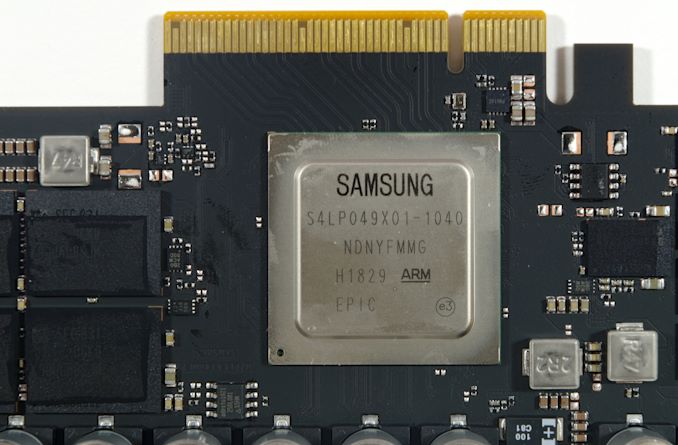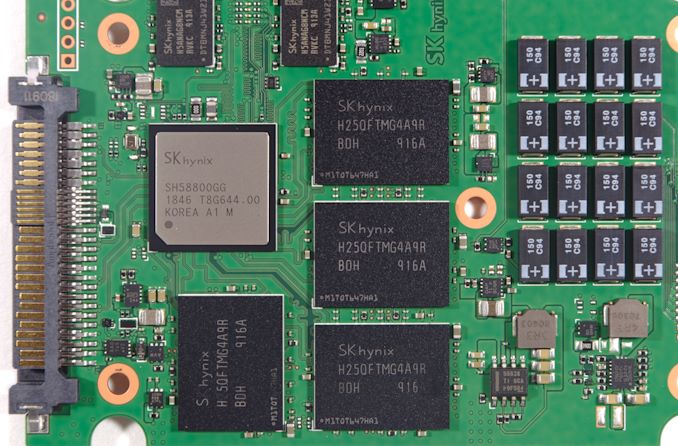Enterprise NVMe Round-Up 2: SK Hynix, Samsung, DapuStor and DERA
by Billy Tallis on February 14, 2020 11:15 AM ESTDrives In Detail: Samsung & SK hynix
Samsung PM1725a
The Samsung PM1725a is a flagship high-end model that's a few generations old. Like the Micron 5100 MAX that was in our recent SATA review, we're testing this because MyDigitalDiscount has a batch of the 6.4TB model that they're selling for just 19 cents/GB - less than many high-end consumer NVMe drives.
Despite its age, the 6.4 TB Samsung PM1725a is by several metrics the fastest SSD we have ever tested, and one of only two drives in our collection that can hit more than 1 million IOPS for 4kB random reads. The PM1725a is also rated for 5 drive writes per day, more than most current-generation high-end enterprise SSDs, and even more the successor PM1725b (3 DWPD) that replaced 48L 3D TLC with 64L TLC and slightly increased performance.
| Samsung PM1725a SSD Specifications | |||
| Form Factor | U.2 | PCIe Add-In Card | |
| Controller | Samsung S4LP049X01 "EPIC" | ||
| Form Factor | 2.5" 15mm U.2 | PCIe HHHL AIC | |
| Interface, Protocol | PCIe 3.0 x4 NVMe 1.2 |
PCIe 3.0 x8 NVMe 1.2 |
|
| Capacities | 800 GB 1.6 TB 3.2 TB 6.4 TB |
1.6 TB 3.2 TB 6.4 TB |
|
| NAND Flash | Samsung 512Gbit 48L 3D TLC | ||
| DRAM | Samsung 8Gbit DDR3-1866 | ||
| Sequential Read | 3.3 GB/s | 6.2 GB/s | |
| Sequential Write | 3.0 GB/s | 2.6 GB/s | |
| Random Read | 800k IOPS | 1000k IOPS | |
| Random Write | 160k IOPS | 180k IOPS | |
| Power Draw |
Max | 23 W | 21 W |
| Idle | 8 W | 7.5 W | |
| Write Endurance | 5 DWPD | 5 DWPD | |
| Warranty | 5 years | ||
A big part of why the PM1725a is so fast is that there's simply a lot of SSD here. The controller (labeled "EPIC") is massive, with a PCIe x8 uplink and 16 channels for interfacing with the NAND. The usable capacity is 6.4 TB, but the drive has 8 TB of flash onboard, meaning that this drive has more internal spare area than the usable capacity of the smallest SSD in this review. All these chips and the 8-lane uplink require a PCIe add-in card form factor, with a large heatsink to dissipate over 20W.
The PM1725a is a little bit outdated by only supporting version 1.2 of the NVMe spec, but it implements almost all of the optional features, including support for multiple namespaces and SR-IOV virtualization so this massive drive can be shared among several virtual machines with minimal overhead.
SK hynix PE6011
SK hynix currently holds fifth place in the overall SSD market (by drives shipped), but they're one of only three companies that is fully vertically integrated: they make their own 3D NAND, DRAM, controller, firmware and SSDs. Now that their 3D NAND seems to be catching up with the rest of the market, that vertical integration may help them significantly improve their standing in the marketplace, but they have fairly low visibility in some important market segments. They have seen the most success in the client OEM SSD market and have reentered the consumer retail market, but enterprise and datcenter SSDs are where the best profit margins can usually be found.
| SK hynix PE6000 Series NVMe SSD Specifications | |||||||
| Model | PE6011 | PE6031 | |||||
| Controller | SK hynix SH58800GG | ||||||
| Form Factor | 2.5" 7mm U.2 | ||||||
| Interface, Protocol | PCIe 3.0 x4 NVMe 1.3a | ||||||
| Capacities | 960 GB | 1.92 TB | 3.84 TB | 7.68 TB | 800 GB 1.6 TB 3.2 TB 6.4 TB |
||
| NAND Flash | SK hynix 512Gbit 72L 3D-V4 TLC | ||||||
| DRAM | SK hynix DDR4 | ||||||
| Sequential Read | 3.2 GB/s | 3.2 GB/s | |||||
| Sequential Write | 650 MB/s | 1250 MB/s | 2.3 GB/s | 2.45 GB/s | 2.45 GB/s | ||
| Random Read IOPS | 220k | 410k | 620k | 610k | 620k | ||
| Random Write IOPS | 27k | 50k | 67k | 70k | 160k | ||
| Power Draw |
Read | 8.0 W | 8.0 W | 8.5 W | 10.0 W | 10 W | |
| Write | 6.0 W | 8.0 W | 12.0 W | 14.0 W | 14 W | ||
| Idle | 3.5 W | 3.7 W | |||||
| Write Endurance | 1 DWPD | 3 DWPD | |||||
| Warranty | 5 years | ||||||
The SK hynix PE6011 and its sibling PE6031 are low-power datacenter NVMe SSDs, using the same 2.5"/7mm form factor as consumer SATA drives, but with a U.2 connector to provide a PCIe 3.0 x4 interface. Most enterprise and datacenter U.2 drives instead use a 15mm thick case to allow for stacked PCBs or more cooling and higher power levels. Using their 72-layer 3D TLC NAND, SK hynix can still pack up to 8TB of storage into this case (7.68 TB usable) along with an 8-channel controller of their own design plus the necessary power loss protection capacitors. The lower power limit of the thinner 2.5" form factor does mean the PE6011 is a bit more limited in performance than most of the drives in this review, but there are lots of other SSDs out there for this product segment that we haven't had the chance to test.
The PE6031 (not tested) is pretty much the same hardware as the PE6011, but with a higher overprovisioning ratio: more spare area, less usable capacity. That allows the PE6031 to target more write-heavy workloads with twice the random write performance and an endurance rating of 3 DWPD instead of 1 DWPD. The PE6011 targets the larger market of SSDs for read-intensive workloads.






















33 Comments
View All Comments
PaulHoule - Friday, February 14, 2020 - link
"The Samsung PM1725a is strictly speaking outdated, having been succeeded by a PM1725b with newer 3D NAND and a PM1735 with PCIe 4.0. But it's still a flagship model from the top SSD manufacturer, and we don't get to test those very often."Why? If you've got so much ink for DRAMless and other attempts to produce a drive with HDD costs and SSD performance (hopefully warning people away?) why can't you find some for flagship products from major manufacturers?
Billy Tallis - Friday, February 14, 2020 - link
The division of Samsung that manages the PM17xx products doesn't really do PR. We only got this drive to play with because MyDigitalDiscount wanted an independent review of the drive they're selling a few thousand of.The Samsung 983 DCT is managed by a different division than the PM983, and that's why we got to review the 983 DCT, 983 ZET, 883 DCT, and so on. But that division hasn't done a channel/retail version of Samsung's top of the line enterprise drive.
romrunning - Friday, February 14, 2020 - link
Too bad you don't get more samples of the enterprise stuff. I mean, you have both influencers, recommenders, and straight-up buyers of enterprise storage who read Anandtech.Billy Tallis - Friday, February 14, 2020 - link
Some of it is just that I haven't tried very hard to get more enterprise stuff. It worked okay for my schedule to spend 5 weeks straight testing enterprise drives because we didn't have many consumer drives launch over the winter. But during other times of the year, it's tough to justify the time investment of updating a test suite and re-testing a lot of drives. That's part of why this is a 4-vendor roundup instead of 4 separate reviews.Since this new test suite seems to be working out okay so far, I'll probably do a few more enterprise drives over the next few months. Kingston already sent me a server boot drive after CES, without even asking me. Kioxia has expressed interest in sampling me some stuff. A few vendors have said they expect to have XL-NAND drives real soon, so I need to hit up Samsung for some Z-NAND drives to retest and hopefully keep this time.
And I'll probably run some of these drives through the consumer test suite for kicks, and upload the results to Bench like I did for one of the PBlaze5s and some of the Samsung DCTs.
PandaBear - Friday, February 14, 2020 - link
ESSD firmware engineer here (and yes I have worked in one of the company above). Enterprise business are mostly selling to large system builder so Anandtech is not really "influence" or "recommend" for enterprise business. There are way more requirements than just 99.99 latency and throughput, and buyers tend to focus on the worst case scenarios than the peak best cases. Oh, pricing matters a lot. You need to be cheap enough to make it to the top 3-4 or else you lose a lot of businesses, even if you are qualified.RobJoy - Tuesday, February 18, 2020 - link
Well these are Intel owners here.Anything PCIe 4.0 has not even crossed their minds, and are patiently waiting for Intel to move their ass.
No chance in hell they dare going AMD Rome way even if it performs better and costs less.
romrunning - Friday, February 14, 2020 - link
This article makes my love of the P4800X even stronger! :) If only they could get the capacity higher and the pricing lower - true of all storage, though especially desired for Optane-based drives.curufinwewins - Friday, February 14, 2020 - link
100% agreed, it's such a paradigm shifter by comparison.eek2121 - Friday, February 14, 2020 - link
Next gen Optane is supposed to significantly raise both capacity and performance. Hopefully Intel is smart and prices their SSD based Optane solutions at a competitive price point.curufinwewins - Friday, February 14, 2020 - link
Ok, great stuff Billy! I know it wasn't really the focus of this review, but dang, I actually came out ludicrously impressed with how very small quantities of first gen optane on relatively low channel installments have such a radically different (and almost always in a good way) behavior to flash. Definitely looking forward to the next generation of this product.